Electrophysiological characterization of a putative supporting cell isolated from the frog taste disk
- PMID: 9651197
- PMCID: PMC6793497
- DOI: 10.1523/JNEUROSCI.18-14-05136.1998
Electrophysiological characterization of a putative supporting cell isolated from the frog taste disk
Abstract
Chemosensory cells in vertebrate taste organs have two obvious specializations: an apical membrane with access to the tastants occurring in food, and synapses with sensory axons. In many species, however, certain differentiated taste cells have access to the tastants but lack any synaptic contacts with axons, and a supportive rather than chemosensory function has been attributed to them. Until now, no functional data are available for these taste cells. To begin to understand their role in taste organ physiology, we have characterized with patch-clamp recording techniques the electrophysiological properties of a putative supporting cell-the so-called wing cell-isolated from frog taste disks. Wing cells were distinguished from chemosensory elements by the presence of a typical, sheet-like apical process. Their resting potential was approximately -52 mV, and the average input resistance was 4.8 GOmega. Wing cells possessed voltage-gated Na+ currents sensitive to TTX, and an inactivating, voltage-gated K+ current sensitive to TEA. Current injections elicited single action potentials but not repetitive firing. We found no evidence for voltage-gated Ca2+ currents under various experimental conditions. Amiloride-sensitive Na+ channels, thought to be involved in Na+ chemotransduction, were present in wing cells. Many of the membrane properties of wing cells have been also reported for chemosensory taste cells. The presence of ion channels in wing cells might be suggestive of a role in controlling the microenvironment inside the taste organs or the functioning of chemosensory cells or both. In addition, they might participate directly in the sensory transduction events by allowing loop currents to flow inside the taste organs during chemostimulation.
Figures






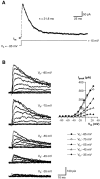
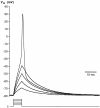
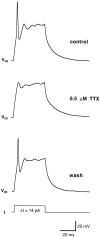
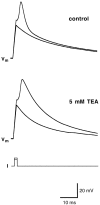
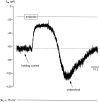

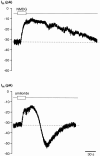
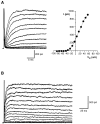
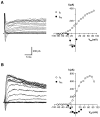
Similar articles
-
Voltage-gated inward currents of morphologically identified cells of the frog taste disc.Chem Senses. 2004 Jan;29(1):61-73. doi: 10.1093/chemse/bjh006. Chem Senses. 2004. PMID: 14752041
-
Characteristics of action potentials and their underlying outward currents in rat taste receptor cells.J Neurophysiol. 1996 Feb;75(2):820-31. doi: 10.1152/jn.1996.75.2.820. J Neurophysiol. 1996. PMID: 8714655
-
Amiloride-sensitive sodium currents in identified taste cells of the frog.Neuroreport. 2001 May 25;12(7):1315-21. doi: 10.1097/00001756-200105250-00006. Neuroreport. 2001. PMID: 11388403
-
Role of apical ion channels in sour taste transduction.Ciba Found Symp. 1993;179:201-10; discussion 210-7. doi: 10.1002/9780470514511.ch13. Ciba Found Symp. 1993. PMID: 7513271 Review.
-
Mechanisms of chemosensory transduction in taste cells.Int Rev Neurobiol. 1990;32:241-79. doi: 10.1016/s0074-7742(08)60585-1. Int Rev Neurobiol. 1990. PMID: 1706688 Review.
Cited by
-
Action potentials and ion conductances in wild-type and CALHM1-knockout type II taste cells.J Neurophysiol. 2017 May 1;117(5):1865-1876. doi: 10.1152/jn.00835.2016. Epub 2017 Feb 15. J Neurophysiol. 2017. PMID: 28202574 Free PMC article.
-
Effects of temperature on action potentials and ion conductances in type II taste-bud cells.Am J Physiol Cell Physiol. 2023 Jul 1;325(1):C155-C171. doi: 10.1152/ajpcell.00413.2022. Epub 2023 Jun 5. Am J Physiol Cell Physiol. 2023. PMID: 37273235 Free PMC article.
References
-
- Akabas MH, Dodd J, Al-Awqati Q. Identification of electrophysiologically distinct subpopulations of rat taste cells. J Membr Biol. 1990;114:71–78. - PubMed
-
- Avenet P, Lindemann B. Patch-clamp study of isolated taste receptor cells of the frog. J Membr Biol. 1987;97:223–240. - PubMed
-
- Avenet P, Lindemann B. Amiloride-blockable sodium currents in isolated taste receptor cells. J Membr Biol. 1988;105:245–255. - PubMed
-
- Barres BA, Chun LLY, Corey DP. Ion channels in vertebrate glia. Annu Rev Neurosci. 1990;13:441–474. - PubMed
-
- Barry PH, Lynch JW. Liquid junction potentials and small cell effects in patch clamp analysis. J Membr Biol. 1991;121:101–117. - PubMed
Publication types
MeSH terms
Substances
LinkOut - more resources
Full Text Sources
Miscellaneous
